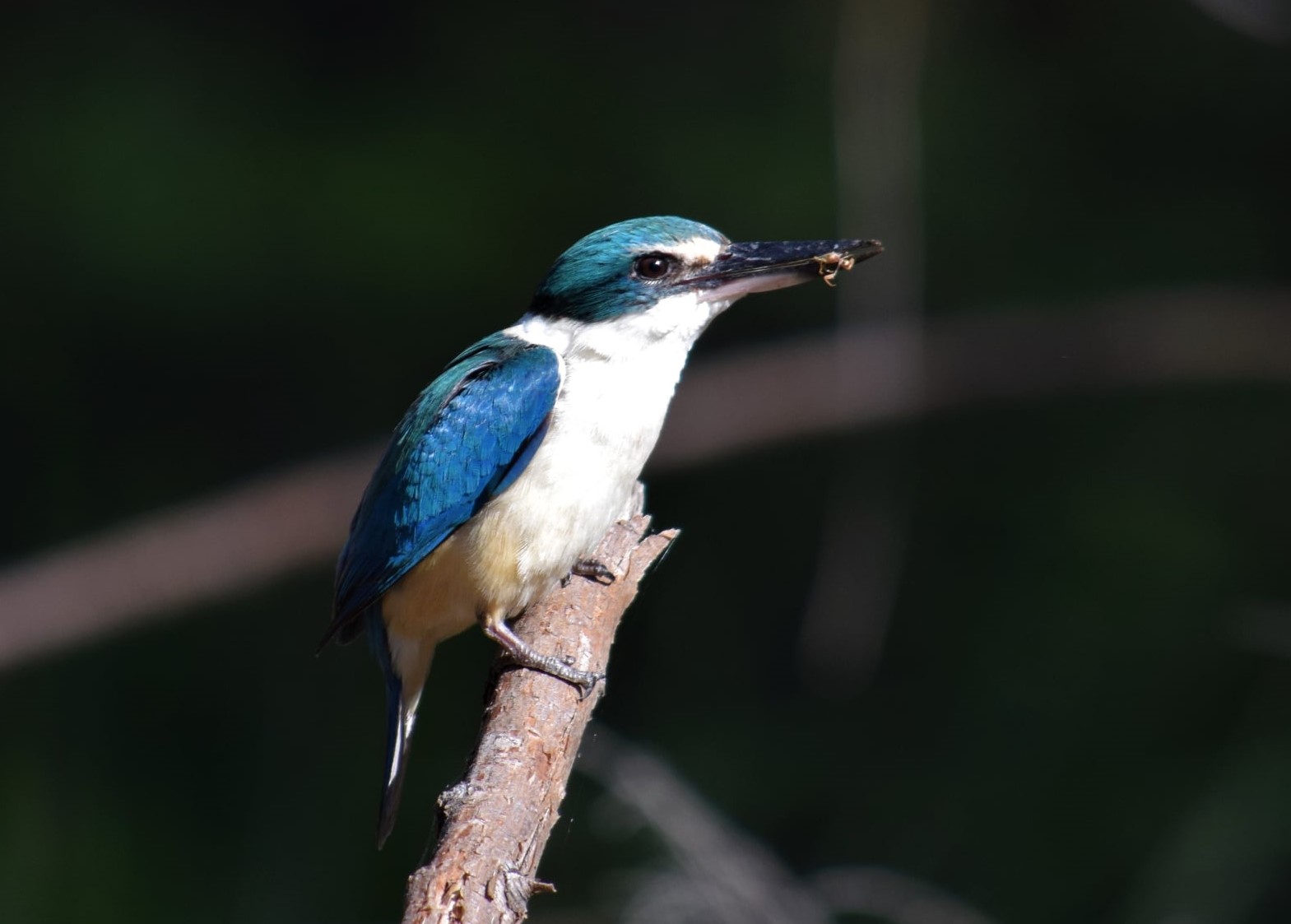
The Bellbirds are a constant background sound in the daytime. They live in the tall eucalypts and make a different sound when they feel threatened. If you hear harsh chirps from a group of bellbirds you might find a goanna in the tree or another species of bird they are trying to chase away.
The Whipbird call is actually two birds. The male bird does the ‘whip’ part and the female finishes with two ‘chirps’ at the end. They feed on the forest floor and in the lower bushes and ferns. If you are lucky you might end up between the male and female and hear the call in ‘stereo’. The male bird has a crest.
King Parrots sometimes visit the cabins and talk to you from the trees. Some of them are quite tame. A flash of colour when you are driving in could be the Crimson Rosella or the Eastern Rosella. Look out for turquoise grass parrots along the road from Killarney.
The song of the Albert’s Lyrebird is one of the strongest and most beautiful of calls. The male lyrebird sings in the mating season (winter to spring), and at other times, during the day from dawn till just after dark. They also mimic other sounds and also other birdcalls. The male lyrebirds have a number of ‘platforms’, where they sing and display, on the opposite side of the creek to the cabins. There is a lyrebird platform you can see at the top of the ‘Circuit Track’ but please don’t touch it. The lyrebirds also have another call, which is called ‘gronking’ which sounds a bit like a large chook. Sometimes guests who have slept in or are extremely quiet have seen the lyrebirds near the cabins and a couple times even on the verandah.
Bowerbirds often take small blue objects from around the cabins. The satin bowerbird is blue-black and is often accompanied by a number of females. They all have beautiful violet eyes. The male is a great mimic and actor. One day we were trying to find a bowerbird bower by following the bowerbird call. After following the call in one direction we heard a lyrebird call close by in another direction, then a bowerbird call in another direction. This continued till we became so confused we did not know whether we were following both bowerbirds and lyrebirds, or either a very clever lyrebird or an equally clever bowerbird. We had to give up. They won!
Catbirds are heard late in the afternoon or early in the morning. They make a meowling sound which we used to think sounded like a baby gurgling. They are olive and green and are hard to see in the forest. At Bert cabin and sometimes Ruby cabin, the catbirds can tap on the windows very early in the morning. They fly away if you sit up in bed and come back again if you lie down again!
A flash of orange-brown in the rainforest could be a Rufous Fantail twitching and spreading its tail to stir up insects which it feeds on.
Some guests walking quietly on the circuit track have been lucky enough to see the Noisy Pitta on the forest floor and once one was photographed on the middle of the track. These birds forage on the forest floor and are very colourful, though seldom seen.
When we hear the plaintive screech of the Black Cockatoos flying up the gorge over the treetops, we feel like we are listening to an ancient ritual as they traverse the rainforests. Black Cockatoos often feed very quietly on the seeds of the casuarina on the mountain slopes. A few times we have only become aware of them when half chewed seed capsules land on our heads when we are standing under casuarinas in the forest! Also look out for the white Sulphur-Crested Cockatoos and the Corellas in the paddocks on the road from Killarney.
You might see the female Paradise Riflebird eating spiders around the edges of the windows. She can look a bit similar to a female bower bird but has a distinctive large, curved beak. The male has shiny dark plumage with beautiful turquoise patches.
If you walk along Adjinbilly Road down to the river early in the morning you often see fairy wrens (including the Superb and Variegated Fairy Wrens), quails, red browed firetails and other species in the grasses and lomandra along the way.
Of course we have the ubiquitous Brush Turkey. There is a large nesting mound on the circuit track where you can see the work they do just so they can hatch their eggs.
There are some beautiful rainforest pigeons and doves in the rainforest. they mostly feed on berries and fruit. You often see them (as well as bower birds) feeding on the yellow berries in the white cedars (there’s one near the woodshed), You usually hear their calls every day and can range from a whoop whoop sound to a repetitive single note. We commonly see the Brown/Chocolate Pigeon, Emerald Dove, White Headed Dove, Wonga Pigeon and the colourful Wompoo with it’s mysterious ‘wollack-a-woo’ call.
If you use binoculars you can often see the Wedge Tailed Eagles on and around the cliffs or sometimes circling in the thermals of the gorge. Kites, Hawks, Goshawks and Falcons are often seen, sometimes on fence posts looking for prey.
Some guests have seen large owls at night around the cabins. There is a photo of one in the cabin booklets.
There are beautiful waterbirds through the gorge. We often see the Azure Kingfisher, Darters, Herons, Ducks, Cormorants and Rail along the river.
There are many other experiences you can have with birds at Adjinbilly. The cabin booklet has a section which lists birds seen at Adjinbilly, together with photographs. You can also go to the gallery to see more photos of birds at Adjinbilly. Plus, we also have excellent bird books in our library which can be borrowed while you are here.
A common sound at night on the ground around the cabins at night is the snorting of the bandicoots as they forage on the forest floor. They have a nightly routine and if you are very still they can come quite close to you before they realise you are there. Then they snort and scamper away.
If you see an animal that looks like a rat it would probably be the carnivorous marsupial Antechinus. Ask us about them when you are here and we’ll tell you some interesting stories about them and their lifecycle!
You often hear the possums growling and screeching when they have disagreements in the rainforest at night and sometimes you hear the koalas growling as they move through the forest at night.
Adjinbilly Creek is a habitat for some rare and also endangered species of frogs and protected red and white rainforest crayfish. In the months of November to January, fireflies are often seen near the creek after dark flickering through the trees. The spectacular glow worms shine at night all year round.
The vulnerable Brush Tailed Rock Wallaby lives on the tops of the ridges above Adjinbilly.
If you are extremely quiet and very lucky you might see the very shy quoll. You can identify it by the orange fur with white spots.
There are lots of wallabies through the gorge. There is a black coloured family of wallaroos that occasionally are seen near Bullocky Crossing. They are seen in larger numbers in the late afternoon and dusk.
There are different species of lizards, and goannas (monitors) are often seen in the gorge. There is a small lizard called a Southern angle-headed dragon which you often see around the cabins and in the rainforest. They are well camouflaged and remain completely still until you get very close to them – then they suddenly scurry off through the forest as fast as they can daring you to catch them!
And of course we have the wonderful platypus in the river through the gorge. I never lose the fascination of seeing them in their natural environment. You can read more about them in the cabin booklets.
If you would like to learn more about the wildlife and plants at Adjinbilly, there is a library from which you can borrow during your stay, which includes colour photo books about rainforest birds, frogs, snakes, animals, plants and trees etc.
Processed food is not the normal native animal diet so we ask that you resist the urge to share your meals with them. Condamine River Road (the road you travelled to arrive at Adjinbilly) makes for excellent walking with spectacular views of the gorge, and wildlife that includes platypus, birds and several species of wallaby.

‘A place of constant water’
A place to relax to the rhythm of nature, to truly get away from it all
A place of romance and discovery… with just a twist of adventure!
Visit us for a while…
Copyright © 2025. Adjinbilly. All Rights Reserved. Website by Wolf IQ